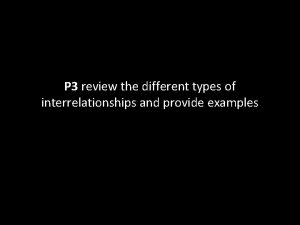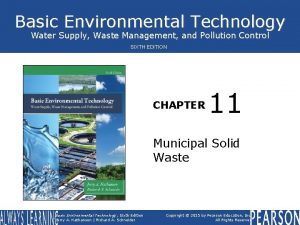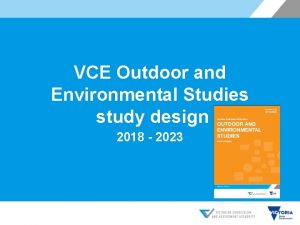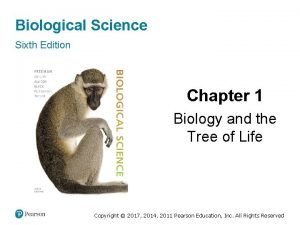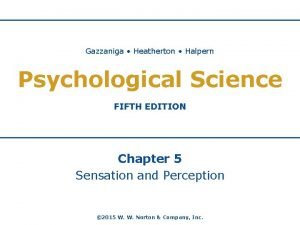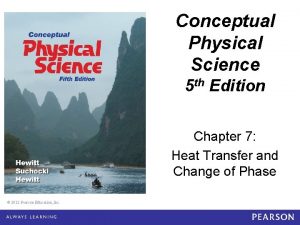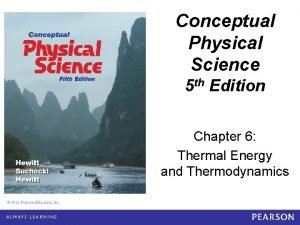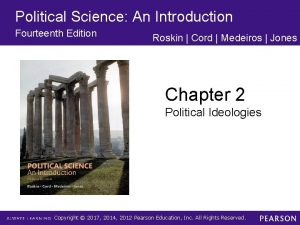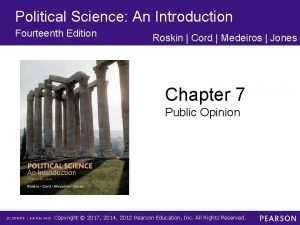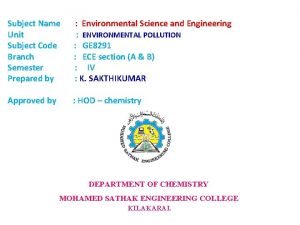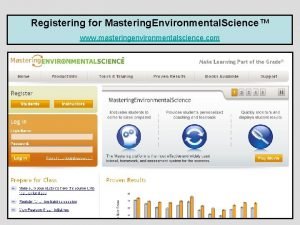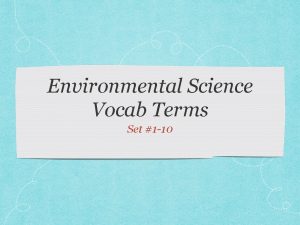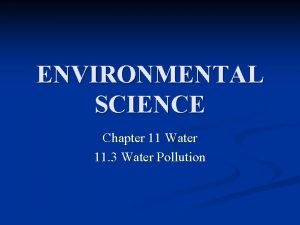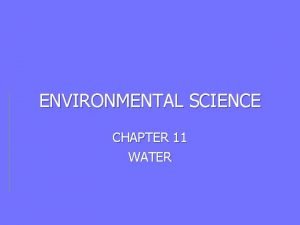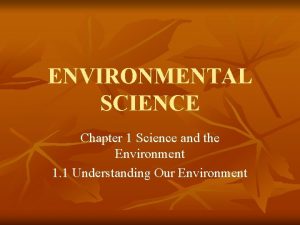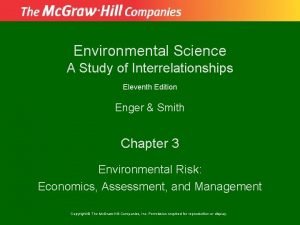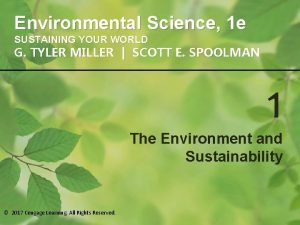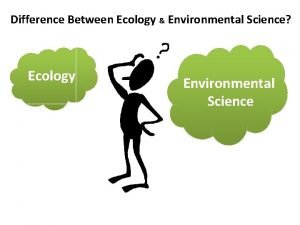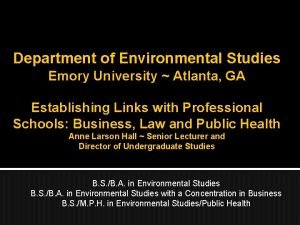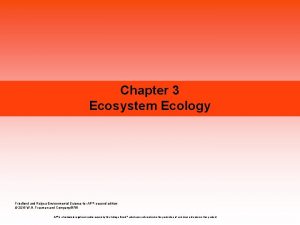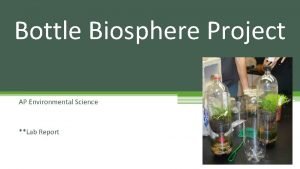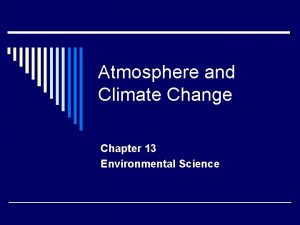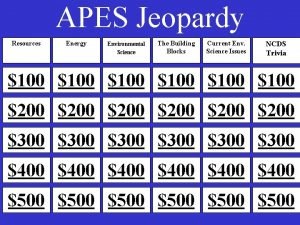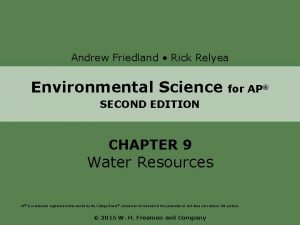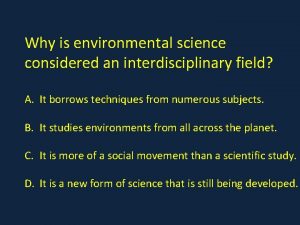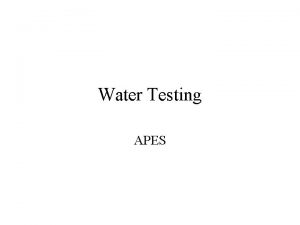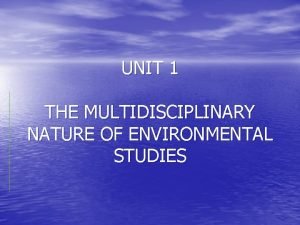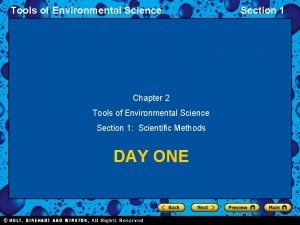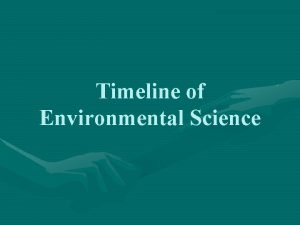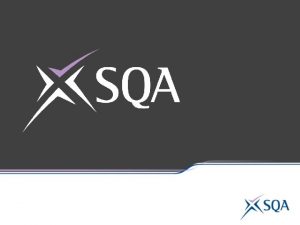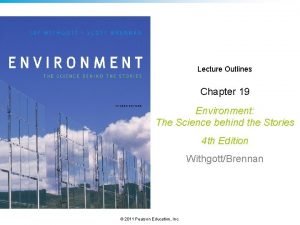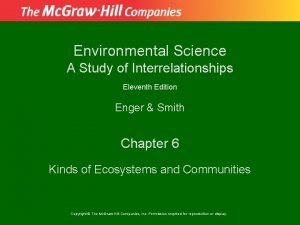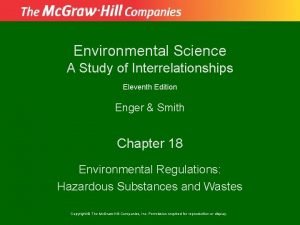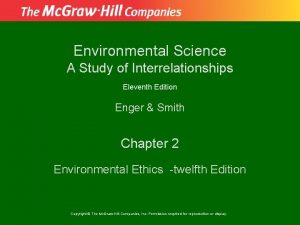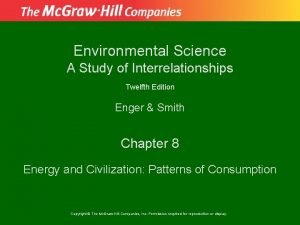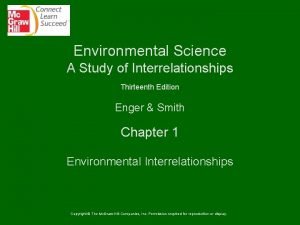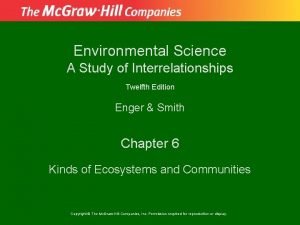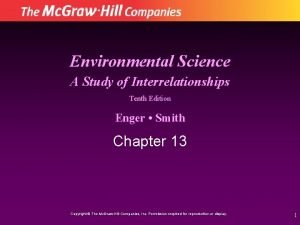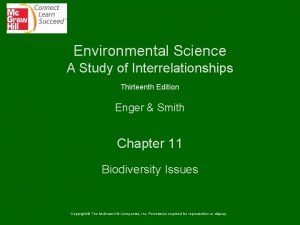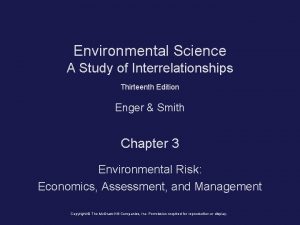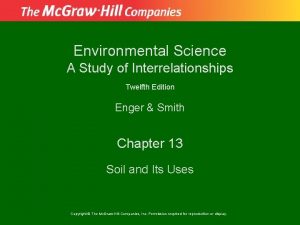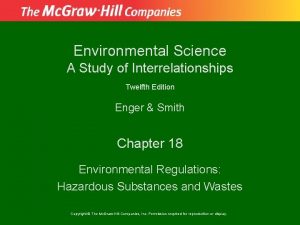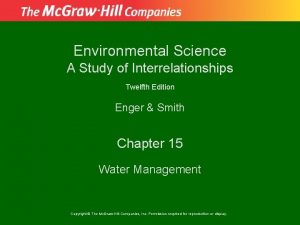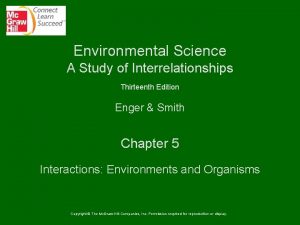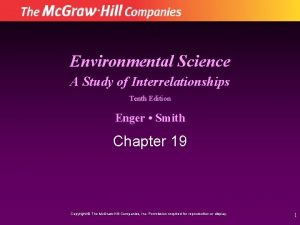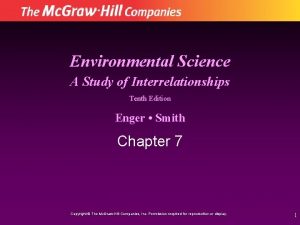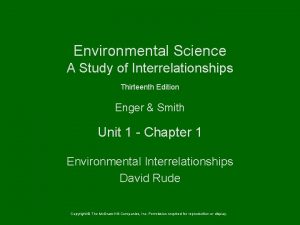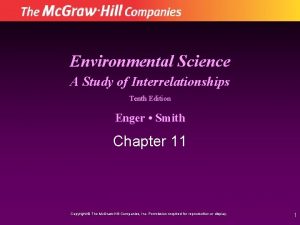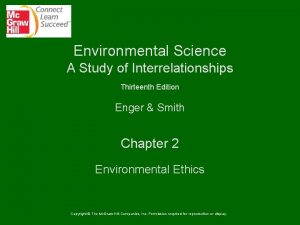Environmental Science A Study of Interrelationships Eleventh Edition






















































- Slides: 54

Environmental Science A Study of Interrelationships Eleventh Edition Enger & Smith Chapter 3 Environmental Risk: Economics, Assessment, and Management Copyright © The Mc. Graw-Hill Companies, Inc. Permission required for reproduction or display.

Environmental Risk: Economics, Assessment, and Management

Outline § § Characterizing Risk and Economics Environmental Economics Using Economic Tools to Address Environmental Issues § Economics and Sustainable Development § Economics, Environment, and Developing Nations

Characterizing Risk § § Risk is the probability that a condition or action will lead to an injury, damage, or loss. Risk incorporates three main considerations: 1. Probability of a bad outcome. – Probability is a mathematical statement about how likely it is that something will happen. 2. Consequences of a bad outcome. 3. Cost of dealing with a bad outcome.

Risk and Economics § Most decisions in life involve an analysis of two factors: • Risk • Cost § Most environmental decisions involve finding a balance between the perceived cost of enduring the risk and the economic cost of eliminating the conditions that pose the risk.

Risk and Economics Decision-making process

Risk Assessment § Environmental risk assessment uses facts and assumptions to estimate probability of harm to human health or the environment that may result from particular management decisions. • The assessment process provides an orderly, clearly stated, and consistent way to deal with scientific issues when evaluating whether a risk exists, the magnitude of the risk, and the consequences of the negative outcome of accepting the risk.

Risk Assessment § If a situation is well-known, scientists use probabilities based on past experience to estimate risks. § Models are used to estimate risks for situations with no known history. • Most risk assessments are statistical statements that are estimates of the probability of negative effects. • These estimates are modified to ensure that a lack of complete knowledge does not result in an underestimation of risk.

Risk Assessment § Because of uncertainties, government regulators have decided to err on the side of safety to protect the public health. • Many of the most important threats to human health and the environment are highly uncertain.

Risk Management § Risk management is a decision-making plan that weighs policy alternatives and selects the most appropriate regulatory action by integrating risk assessment results with engineering data, and with social, economic, and political concerns. • The purpose is to reduce the probability or magnitude of a negative outcome.

Risk Management § A risk management plan includes: • Evaluating the scientific information regarding various kinds of risks. • Deciding how much risk is acceptable. • Deciding which risks should be given highest priority. • Deciding where the greatest benefit would be realized by spending limited funds. • Deciding how the plan will be enforced and monitored.

Risk Management § From a risk management standpoint, whether one is dealing with a site-specific situation or a national standard, the deciding question is: § What degree of risk is acceptable? § Negligible risk is the point at which there is no significant health or environmental risk. • At what point is there an adequate safety margin to protect public health and the environment ?

Risk Tolerance § Business and industry must have management policies or risk tolerance programs, either formal or understood. § Each entity has some level of risk it is willing to accept. § Depending on the situation, policies and/or tolerance for environmental health and safety risks can vary greatly. § The more familiar or well understood the issues are, the greater the level of risk that is acceptable.

True and Perceived Risks § People often overestimate frequency and seriousness of sensational causes of death, and underestimate risks from familiar causes that claim lives one by one. • The public generally perceives involuntary risks as greater than voluntary risks, and perceives newer technologies as greater risks than old, familiar technologies.

True and Perceived Risks Perception of risks

True and Perceived Risks § One of the most profound dilemmas facing decision makers is how to address the discrepancy between the scientific and the public perceptions of environmental risks. • Should the government focus available resources and technology where they can have with the greatest impact, or on problems about which the public is most upset?

Environmental Economics § Economics is the study of how people choose to use resources to produce goods and services, and how those goods and services are distributed to the public.

Resources § Economists look at resources as the available supply of something that can be used. § There are three categories of resources: • Labor (human resources) • Capital (technology and knowledge) • Land (natural resources)

Resources § Natural resources are structures and processes humans can use for their own purposes but cannot create. • Renewable resources can be formed or regenerated by natural processes. • Nonrenewable resources are not replaced by natural processes, or the rate of replacement is so slow as to be ineffective.

Supply and Demand § Supply is the amount of a good or service people are willing to sell at a given price. § Demand is the amount of a good or service that consumers are willing and able to buy at a given price. § The relationship between supply and demand is often illustrated by a supply/demand curve. • Price reflects the strength of demand for and availability of the commodity. – Demand > Supply: Price Rises – Demand < Supply: Price Lowers

Supply and Demand Supply and demand for old corrugated cardboard.

Assigning Value to Natural Resources § We assign value to natural resources based on our perception of their relative scarcity. • If a natural resource has always been rare, it is expensive. • If the supply is very large and the demand is low, the resource is often perceived to be free. • Even renewable resources can be overexploited.

Environmental Costs § Pollution, species extinction, resource depletion, and loss of scenic quality are all examples of the environmental costs of resource exploitation. § Deferred costs are those that may not be immediately recognized and must be paid at a later date. • Agricultural soil erosion § External costs are those that are borne by someone other than the individuals using the resource. • Cleanup of hazardous waste sites

Environmental Costs § Pollution costs are expenditures to correct pollution damage once pollution has already occurred. § Pollution prevention costs are those incurred to prevent pollution that would otherwise result from some production or consumption activity.

Cost-Benefit Analysis § Cost-benefit analysis is a formal quantitative method of assessing costs and benefits of competing uses of a resource, or solutions to a problem, and deciding which is most effective.

Cost-Benefit Analysis § It is used to determine whether a policy generates more social costs than social benefits and, if benefits outweigh costs, how much activity would obtain optimal results. § There are four steps in a cost-benefit analysis: • • Identification of the project. Determination of all impacts. Determination of the value of impacts. Calculation of net benefit.

Concerns About the Use of Cost-Benefit Analysis § Not everything can be analyzed from an economic point of view, or can be assigned an economic value. § Analyst must decide which preferences have standing in the analysis.

Common Property Resource Problems § Common (public) ownership essentially means no owner. • Strong tendency to overexploit and misuse the resource. • Common ownership makes it virtually cost-free for anybody to cause pollution.

Comparing Economic and Ecological Systems § Matching economic processes with environmental resources is difficult because of the great differences in the way economic systems and ecological systems function. § There is a great difference in the time frames in which ecosystems and markets operate. • Ecosystem processes take place over tens of thousands to millions of years. • Market processes take from a few minutes to a few years.

Comparing Economic and Ecological Systems § For ecosystems, place/space is critical and the capacities of a given location are not transferable. § Economics and ecology are measured in different units.

Common Property Resource Problems— The Tragedy of the Commons § Economists have stated that when everybody shares ownership of a resource, there is a strong tendency to overexploit and misuse that resource. § The problems inherent in common ownership of resources were outlined by biologist Garrett Hardin in his essay “The Tragedy of the Commons” (1968).

Common Property Resource Problems— The Tragedy of the Commons § The “Commons” were pasturelands in England provided free by the king to anyone wishing to graze cattle. § There are no problems on the commons as long as the number of animals is small in relation to the size of the pasture. § However, the optimal individual strategy is to enlarge one’s personal herd as much as possible.

Common Property Resource Problems— The Tragedy of the Commons § As each herder pursues the optimal strategy: • Each herd increases in size. • Commons becomes overgrazed. • Everyone loses as the animals die of starvation. • Even though the eventual result is clear, no one acts to avert disaster.

Common Property Resource Problems— The Tragedy of the Commons § The ecosphere is a large commons. • The U. S. and other industrialized nations consume more than their fair share of resources. – Harvesting of marine organisms. – Common ownership of parks and streets. § Tragedy of the Commons also operates on an individual scale.

Using Economic Tools to Address Environmental Issues § A subsidy is a gift from the government to individuals or private enterprise to encourage actions considered important to the public interest. • Subsidies are useful when they have a clear purpose and are used for short transition periods. • When used inappropriately, subsidies can lead to economic distortions. – Keeps price of a good or service below true market value. – May encourage activities detrimental to the environment. • Once subsidies become part of the economic fabric of a country, they are very difficult to eliminate.

Liability Protection and Grants for Small Business § On Jan. 11, 2002, President George W. Bush signed into law the Small Business Liability Relief and Brownfield Revitalization Act (SBLRBRA). § This law provides incentives for small businesses and other entities to develop brownfields (areas perceived to have environmental liabilities), most of which are in urban areas.

Liability Protection and Grants for Small Business § These areas were previously considered too risky to purchase and develop since purchasers could potentially acquire the environmental liabilities associated with the property. § The program has resulted in many successful projects that have brought business back to where it once was, minimizing impact on green belts outside urban areas.

Market-Based Instruments § Market-based instruments use economic forces and the ingenuity of entrepreneurs to achieve a high degree of environmental protection at a low cost. • Because of subsidies and external costs, many environmental resources are underpriced. • These instruments can be used to determine fair prices for environmental resources.

Market-Based Instruments § Instruments currently in use: • Information Programs provide consumers with information about environmental consequences of purchasing decisions. • Tradable emissions permits give companies the right to emit specified amounts of pollutants. – Permits can be sold or banked for future use.

Market-Based Instruments • Emission fees and taxes provide incentives for environmental improvement by making damaging activities and products more expensive. • Deposit-refund programs place a surcharge on the price of a product which is refunded upon return for reuse or recycling. • Performance bonds are fees collected to ensure proper care is taken to protect environmental resources.

Life Cycle Analysis and Extended Product Responsibility § Life-cycle analysis is the process of assessing environmental effects associated with production, reuse, and disposal of a product over its entire useful life. • This process can identify changes in product design and process technology that would reduce the ultimate environmental impact of the product.

Life Cycle Analysis and Extended Product Responsibility § Extended product responsibility is the concept that the producer of a product is responsible for all negative effects involved in its production, including the ultimate disposal of the product. • The logic is that if manufacturers pay for postconsumer impacts, they will alter designs in order to reduce waste.

Life Cycle Analysis and Extended Product Responsibility § Benefits of extended product responsibility: • Cost savings • Increased design efficiency • More efficient environmental protections § Obstacles • • • Cost of instituting programs Lack of assessment tools and information Difficulty in building working relationships Hazardous waste regulations Antitrust laws

Economics and Sustainable Development § Sustainable development has become an important policy priority for the world. § Sustainable development is development that meets present needs without compromising the ability of future generations to meet their own needs. • Most definitions refer to the viability of natural resources and ecosystems over time, and to maintenance of human living standards and economic growth.

Economics and Sustainable Development § Characteristics that define sustainability: • • • Renewability Substitution Interdependence Adaptability Institutional commitment

Economics and Sustainable Development § Schools of thought: • Economic growth finances the investments necessary to prevent pollution and to improve the environment by a better allocation of resources. • Science and technological advances can solve many environmental problems. • Economic and environmental well-being are mutually reinforcing, and must be simultaneously pursued if either is to be reached.

Economics and Sustainable Development § For sustainable development to be a viable concept, modern, environmentally sound technology must be transferred to developing nations. § Another major obstacle to sustainable development in many countries is a social structure that gives majority of wealth to a tiny minority of the population.

Economics and Sustainable Development § Sustainable development requires choices based on values. § High-income developed nations with high education levels are in a position to promote sustainable development. • They have the resources to invest in research and the technologies to implement their findings. • Some believe the world should not impose environmental protection standards on poorer nations without also helping them to move into the economic mainstream.

Economics, Environment, and Developing Nations § Many countries in the developing world have resources that they wish to develop in order to improve the economic conditions of their inhabitants. § To pay for development projects, many economically poor nations must borrow money from developed nations. § This debt creates a perverse incentive to overexploit their resources.

Economics, Environment, and Developing Nations § Debt-for-nature exchanges are an innovative mechanism for addressing the debt issue while encouraging investment in conservation and sustainable development. • The conservation organization buys the debt from the creditor at a discount. • Although the creditor receives only partial payment of the initial loan, some return is better than a total loss.

Economics, Environment, and Developing Nations • The debtor country has the debt removed and is relieved of the huge burden of paying interest on the debt. • In exchange, the conservation organization requires the debtor country to spend money on appropriate conservation and sustainable development projects. § The primary goal of debt-for-nature exchanges has not been debt reduction but the funding of natural-resource management investment.

Summary § Risk is the probability that a condition or action will lead to an injury, damage, or loss. § Risk assessment is the use of facts and assumptions to estimate the probability of harm to human health or the environment that may result from exposures to pollutants or toxic agents. § Cost-benefit analysis is concerned with whether a policy generates more social benefits than social costs.

Summary § Criticism of cost-benefit analysis is based on the question of whether everything has an economic value. § There is a strong tendency to overexploit and misuse resources that are shared by all. § Economic policies and concepts, such as supply and demand subsidies, play important roles in environmental decision making. § Recently, several kinds of market-based approaches have been developed to deal with the economic costs of environmental problems.

Summary § Sustainable development has been defined as actions that address the needs of the present without compromising the ability of future generations to meet their own needs. § Sustainable development requires choices based on values. § Economic concepts are also being applied to debt-laden developing countries.
 Management eleventh edition stephen p robbins
Management eleventh edition stephen p robbins Management eleventh edition stephen p robbins
Management eleventh edition stephen p robbins Management eleventh edition
Management eleventh edition Management eleventh edition
Management eleventh edition Chadha committee
Chadha committee Eleventh 5 year plan
Eleventh 5 year plan Eleventh plan
Eleventh plan For his eleventh birthday elvis presley
For his eleventh birthday elvis presley Dinoflagellates
Dinoflagellates Tui interrelationships
Tui interrelationships Rule of 70 in population growth
Rule of 70 in population growth My favorite subject is math and english
My favorite subject is math and english Using mis (10th edition) 10th edition
Using mis (10th edition) 10th edition Using mis (10th edition) 10th edition
Using mis (10th edition) 10th edition Basic environmental technology
Basic environmental technology Wireless health
Wireless health Prehospital emergency care 11th edition study guide
Prehospital emergency care 11th edition study guide Outdoor ed study design
Outdoor ed study design Chapter 1 chapter assessment the central science
Chapter 1 chapter assessment the central science Biological science 6th edition
Biological science 6th edition Psychological science 5th edition
Psychological science 5th edition When air rapidly expands its temperature normally
When air rapidly expands its temperature normally Microscopic slush in water tends
Microscopic slush in water tends Conceptual physical science 5th edition
Conceptual physical science 5th edition The fundamentals of political science research 2nd edition
The fundamentals of political science research 2nd edition Political science 14th edition
Political science 14th edition Political science 14th edition
Political science 14th edition Science power 9 atlantic edition
Science power 9 atlantic edition Ap environmental science exam pass rate
Ap environmental science exam pass rate Tragedy of the commons easter island
Tragedy of the commons easter island Environmental science subject code
Environmental science subject code Mastering environmental science access code
Mastering environmental science access code Environmental science defination
Environmental science defination Environmental science vocab
Environmental science vocab Objectives of water pollution
Objectives of water pollution Chapter 11 water environmental science
Chapter 11 water environmental science Environmental science chapter 1
Environmental science chapter 1 Tragedy of the commons environmental science
Tragedy of the commons environmental science Ipat model of environmental impact
Ipat model of environmental impact Ecology and environmental science
Ecology and environmental science Emory environmental science
Emory environmental science Npp environmental science
Npp environmental science Bottlebiosphere
Bottlebiosphere Environmental science chapter 13
Environmental science chapter 13 Environmental science jeopardy
Environmental science jeopardy Friedland and relyea environmental science
Friedland and relyea environmental science A science is considered interdisciplinary when weegy
A science is considered interdisciplinary when weegy Ap environmental science water test
Ap environmental science water test Multidisciplinary nature of environmental studies;
Multidisciplinary nature of environmental studies; Chapter 2 assessment environmental science answers
Chapter 2 assessment environmental science answers Environmental science timeline
Environmental science timeline National 5 environmental science
National 5 environmental science Environmental chemistry science olympiad
Environmental chemistry science olympiad Chapter 19 environmental science
Chapter 19 environmental science Chapter 2 economics and environmental policy
Chapter 2 economics and environmental policy









